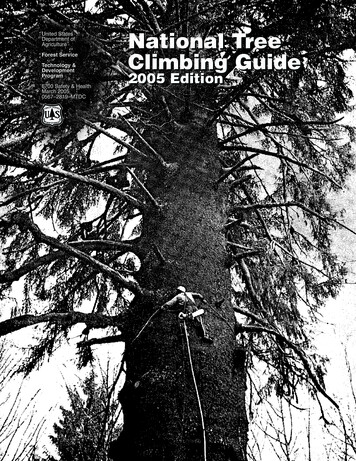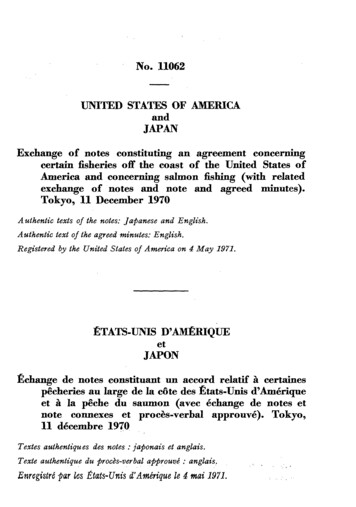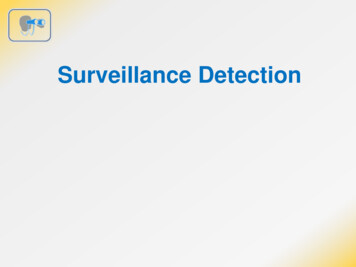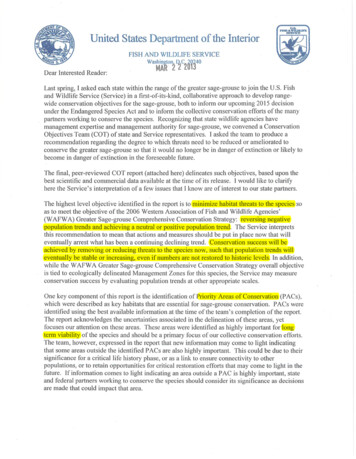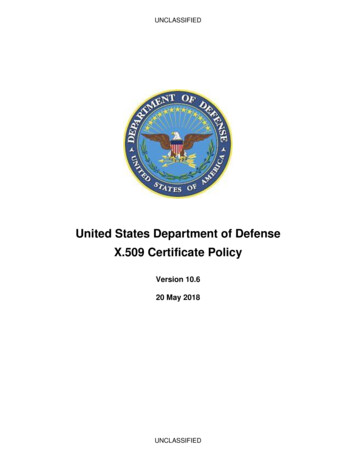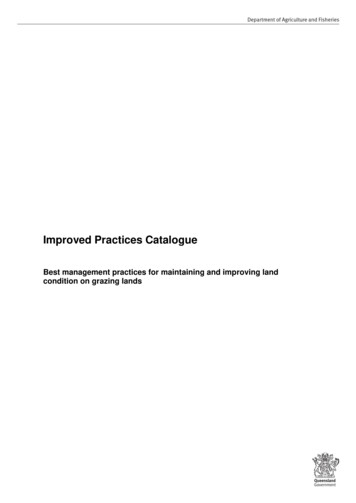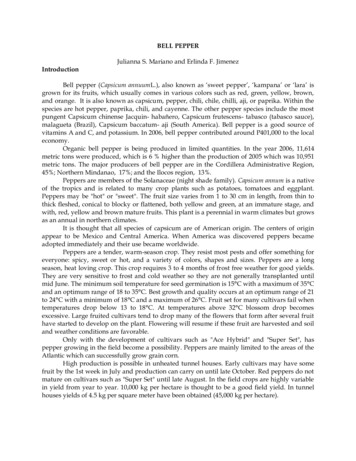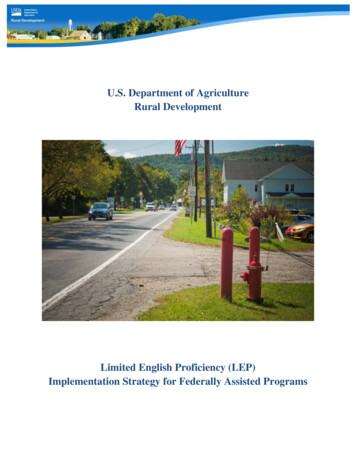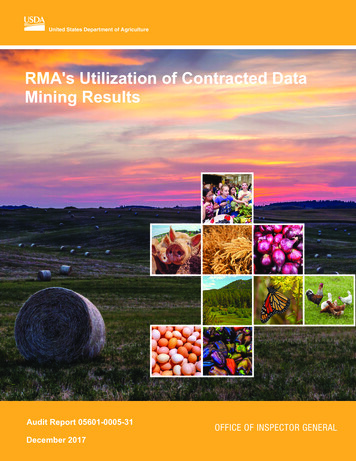
Transcription
United States Department of AgricultureRMA's Utilization of Contracted DataMining ResultsAudit Report 05601-0005-31December 2017OFFICE OF INSPECTOR GENERAL
RMA’s Utilization of Contracted Data Mining ResultsAudit Report 05601-0005-31OIG reviewed RMA’s and approved insurance providers’ use of contracteddata mining results.OBJECTIVEOur objective was to determinewhether the results of the datamining performed by CAE arebeing utilized by RMA and AIPsto administer and enforce cropinsurance program complianceand integrity initiatives.REVIEWEDWe interviewed RMA and CAEofficials to gain an understandingof their roles in the data miningprocess. We also reviewed AIPrecords, data mining reports fromfiscal years 2015 and 2016, andthe spot check list cost avoidancecalculation methodology.RECOMMENDSWe recommended that RMAdevelop and implement aprocess to obtain more detailed,actionable data fromAIP-conducted spot check listreviews; design and implementcontrols to mitigate identifiedproblem areas and weaknesses;ensure all identified anomalousagents or loss adjusters arereviewed; and validate thespot check list cost avoidancemethodology.WHAT OIG FOUNDThe Risk Management Agency (RMA) needs to makeimprovements to maximize the use of data mining resultsto safeguard the integrity of the Federal crop insuranceprogram. We found that RMA is not obtaining theinformation necessary to identify and implement controlsthat mitigate potential problem areas and weaknesses.Therefore, RMA has reduced assurance that potentialFederal crop insurance vulnerability, fraud, waste, orabuse is detected and addressed. In addition, RMA is noteffectively reviewing anomalous insurance agents andloss adjusters on the Agricultural Risk Protection Act of2000 (ARPA) List.ARPA required use of data mining and data warehousingto improve compliance with, and the integrity of,the Federal crop insurance program. To addressthis requirement, RMA contracted with the Centerfor Agribusiness Excellence (CAE) to develop thosetechnologies. Since 2001, CAE has annually produced alist of producers with anomalous losses over time. This iscalled the spot check list.While RMA has been proactive in updating the spotcheck list cost avoidance methodology since its 2001inception, additional factors could be relevant whendetermining cost avoidance. RMA has not validated theupdated spot check list cost avoidance methodology. Asa result, RMA’s reported spot check list cost avoidanceof about 1.16 billion since 2001 could be over orunderstated.RMA agreed with our findings and recommendations,and we accepted management decision on all sevenrecommendations.
United States Department of AgricultureOffice of Inspector GeneralWashington, D.C. 20250DATE:December 19, 2017AUDITNUMBER:05601-0005-31TO:Heather ManzanoActing AdministratorRisk Management AgencyFROM:Gil H. HardenAssistant Inspector General for AuditSUBJECT:RMA’s Utilization of Contracted Data Mining ResultsThis report presents the results of the subject review. Your written response to the official draftreport, dated November 21, 2017, is included in its entirety at the end of this report. Yourresponse and the Office of Inspector General’s (OIG) position are incorporated into the relevantsections of the report. Based on your written response, we are accepting management decisionfor all audit recommendations in the report, and no further response to this office is necessary.The Risk Management Agency provided clarification on four items in our report. We havereviewed the referenced report sections and determined that the report adequately addressesRMA’s points of clarification.In accordance with Departmental Regulation 1720-1, final action needs to be taken within 1 yearof each management decision to prevent being listed in the Department’s annual AgencyFinancial Report. However, we agreed to extend final action for Recommendation 1 untilJune 30, 2019. For agencies other than the Office of the Chief Financial Officer (OCFO), pleasefollow your internal agency procedures in forwarding final action correspondence to OCFO.We appreciate the courtesies and cooperation extended to us by members of your staff during ouraudit fieldwork and subsequent discussions. This report contains publicly available informationand will be posted in its entirety to our website (http://www.usda.gov/oig) in the near future.
Table of ContentsBackground and Objectives . 1Section 1: Use of Data Mining Results . 3Finding 1: RMA Needs to Obtain Better Information from the Spot CheckList Reviews . 3Recommendation 1 .4Recommendation 2 .5Finding 2: RMA Needs to Improve Reviews of Anomalous Insurance Agentsand Loss Adjusters with High Loss Claims . 7Recommendation 3 .8Recommendation 4 .9Recommendation 5 .10Finding 3: RMA Needs to Validate the Cost Avoidance Methodology . 11Recommendation 6 .12Recommendation 7 .14Scope and Methodology . 15Abbreviations . 17Exhibit A: Fieldwork Locations Visited or Contacted . 18Agency's Response . 19
Background and ObjectivesBackgroundThe Department of Agriculture’s (USDA) Risk Management Agency (RMA) manages theFederal Crop Insurance Corporation (FCIC) to provide crop insurance products to America’sfarmers and ranchers.1 RMA approves crop insurance premium rates, administers premium andexpense subsidies, approves and supports products, and reinsures the insurance companies.Approved insurance providers (AIP) sell and service Federal crop insurance policies in everyState and in Puerto Rico through a public-private partnership with RMA. All crop insurancepolicies are available from private crop insurance agents. The Standard Reinsurance Agreementis a cooperative financial assistance agreement between FCIC and an AIP. According toAppendix IV of the Standard Reinsurance Agreement, AIPs are required to conduct data miningreviews and report the results to FCIC.2RMA’s compliance function rests with the Deputy Administrator for Compliance, who conductscompliance reviews through six regional compliance offices (RCO); the Business AnalyticsDivision; the Evaluations, Audits, and Recoveries Division; Appeals and Litigation staff; andSpecial Investigations Staff.The Agricultural Risk Protection Act of 2000 (ARPA) required the Secretary of Agriculture touse data mining and data warehousing to improve compliance with, and the integrity of, theFederal crop insurance program.3 To address this requirement, RMA contracted with the Centerfor Agribusiness Excellence (CAE) at Tarleton State University to develop those technologies.Since 2001, CAE has annually produced a list of producers with anomalous losses over time. 4This is called the spot check list.CAE used 14 scenarios to flag producers with anomalous losses and identified over2,000 distinct producers and over 3,400 crop policies for the 2016 spot check list. The scenariosranged from identifying producers with multi-year anomalous losses to identifying producerswho may have colluded to undermine the integrity of the crop insurance program. Thesescenarios do not indicate that the identified producers have necessarily committed fraudulentacts, but rather that these producers may be worthy of further review because of their anomalouslosses.After the anomalous producers are identified on the spot check list, they are notified andinspected the following year by either the Farm Service Agency (FSA) or an AIP. Theinspections consist of a growing season inspection and a harvest season inspection. FSAinspects half of the crop insurance policies on the list, and AIPs inspect the other half. Prior to1FCIC is a government corporation within USDA that administers the Federal crop insurance program.Data mining is the practice of searching through large amounts of computerized data to find useful patterns ortrends. A data warehouse is a large, centralized collection of digital data gathered from various units within anorganization.3Pub. L. No. 106-224, 114 Stat. 358.4Anomalous is defined as inconsistent with or deviating from what is usual, normal, or expected.2AUDIT REPORT 05601-0005-311
2012, the entire spot check list was sent to FSA for conducting reviews. The spot check list wassplit between FSA and AIPs starting in 2012 because FSA was having difficulty completingreviews due to lack of resources and personnel.5 A single producer is inspected by either FSA oran AIP, but not both.According to CAE, most of the producers identified on the spot check list tend to reduce theirexcessive claims after they are notified and/or reviewed. The cost avoidance that results fromthe spot check list process is measured by the reduction in the amount of indemnities claimedafter the spot check inspections are conducted. According to the 2015 Spot Check List CostAvoidance CAE report, the cost avoidance for the 2015 spot check list was 61 million. Thespot check lists from 2001 through 2015 produced a total cost avoidance of 1.16 billion per thereport.CAE also prepares an annual anomalous insurance agent and adjuster list called the ARPA List.The ARPA List is provided to AIPs to conduct reviews. The ARPA List scenarios range fromidentifying agents who have gained a significant amount of anomalous new business to thosewith producers who claim excessive indemnities relative to others in the same area over manyyears. Each scenario is then used to identify those producer crop policies that are mostresponsible for the agent’s anomalous losses over the same time period. The 2015 ARPA Listscenarios identified 529 distinct policies insured by 16 AIPs and identified 66 agents and14 adjusters. The 2016 ARPA List scenarios identified 1,868 distinct policies insured by16 AIPs and identified 97 agents and 41 adjusters.ObjectivesOur objective was to determine whether the results of the data mining performed by CAE arebeing utilized by RMA and AIPs to administer and enforce crop insurance program complianceand integrity initiatives.5CAE judgmentally assigns some producers to AIPs for review based on a number of factors including the specificscenario that flagged the producer. CAE randomly assigns the remainder of the spot check list between FSA andAIPs.2AUDIT REPORT 05601-0005-31
Section 1: Use of Data Mining ResultsFinding 1: RMA Needs to Obtain Better Information from the Spot CheckList ReviewsRMA is unable to identify potential Federal crop insurance problem areas and weaknesses usingresults from AIP-conducted spot check list reviews. This occurred because RMA has notimplemented a process to obtain detailed, actionable data from AIPs. Specifically, AIPs onlyreport whether or not spot check list reviews were completed and if the application, acreage,production, and claim were “reviewed” or “corrected.” As a result, RMA is not obtaining theinformation necessary to identify and implement controls that could mitigate potential problemareas and weaknesses. Consequently, RMA has reduced assurance that potential Federal cropinsurance vulnerability, fraud, waste, or abuse is detected, deterred, and addressed.One purpose of ARPA was to improve compliance with, and the integrity of, the Federal cropinsurance program.6 ARPA required the Secretary of Agriculture to use data mining and datawarehousing to administer and enforce the Federal crop insurance program.7 ARPA also statesthat RMA shall work actively with AIPs to address program compliance and integrity issues asthey develop.8 According to Appendix IV of the Standard Reinsurance Agreement, AIPs are toimmediately report all cases where they reasonably suspect misrepresentation, fraud, waste, orabuse to RMA. RMA’s compliance staff is responsible for safeguarding the integrity of theFederal crop insurance program by assessing and investigating program vulnerability, fraud,waste, and abuse.To meet ARPA requirements, CAE prepares an annual spot check list using data miningscenarios to flag producers with anomalous losses. CAE splits the spot check list between FSAand AIPs. FSA county offices are to perform a minimum of two documented field inspections ofthe selected producer’s fields: one within 30 calendar days after the final planting date (growingseason inspection) and one before harvest becomes general in the area (pre-harvest inspection).Similarly, AIPs are also to complete growing season and pre-harvest inspections of selectedproducer’s fields. In addition, AIPs are to review and verify the producer’s application, acreagereport, production report, and notice of claim.Each AIP must ensure that all review results are submitted to RMA using the P57 quality controlreporting record in accordance with Appendix IV of the Standard Reinsurance Agreement. Afterconducting reviews, AIPs report to RMA spot check list review completion dates and whetherthe application, acreage, production, and claim were “reviewed” or “corrected.” An RMAnational official said that AIPs do not report the details of what was found, and RMA needs thattype of feedback. The official said that RMA needs a process or a mechanism for gettingfeedback and “closing the loop” from AIP-conducted reviews. In addition, RCO officials statedthat they would like to know more information from AIP-conducted spot check list reviewresults in order to learn about potential problems areas, vulnerabilities, and weaknesses.67 U.S.C. § 1515(a) (1).7 U.S.C. § 1515(j) (2).87 U.S.C. § 1515(a) (2).7AUDIT REPORT 05601-0005-313
AIP officials told us that the AIP spot check list inspection process is a deterrent for producers.AIP officials said that producers and their neighbors see AIP officials conducting spot check listfield inspections, so producers are deterred from doing the wrong thing. AIP officials told usthat such deterrence is why AIPs do not find fraud, waste, and abuse during spot check listreviews. Nevertheless, FSA found more than 100 instances (over 5 percent) where theproducer’s crop conditions were not similar to other farms in the area while conducting its half ofthe spot check list reviews in both 2015 and 2016.9 FSA referred these instances to RMA RCOsfor investigation.When we raised the concern about AIPs not finding fraud, waste, and abuse while FSA finds andrefers over 100 instances a year to RCOs for investigation, an RMA national official said that hehad the same concern. The official said that RMA needs more feedback on what AIPs are seeingduring spot check list reviews. The official also said that AIPs reporting that they corrected arecord does not provide enough information for RMA to determine if it is a systemic issue.Without knowing the specific results of AIP-conducted spot check list reviews, RMA is unableto identify and correct potential systemic issues. As a result, RMA has reduced assurance thatpotential Federal crop insurance program vulnerability, fraud, waste, or abuse is detected,deterred, and addressed.The Government Accountability Office (GAO) previously recommended that RMA develop amechanism, such as a revised electronic form, to collect additional data from insurancecompanies in order to facilitate the use of the companies’ reviews in data mining.10 In responseto the GAO report, RMA stated that it will find better ways to record and gather data for datamining as one of the agency’s information systems projects matures. An RMA national officialsaid, however, that the P57 record was not revised in response to the 2012 GAO reportrecommendation, and the current RMA compliance leadership is uncertain why that is the case.An RMA national official said the current RMA leadership now recognizes the need to obtainmore and better information from AIP spot check list reviews and is in the process of revisingthe P57 record to capture this additional data. The official said that the revised P57 record willcapture information related to root causes and sources of errors AIPs find during reviews. RMAanticipates that the draft P57 record revision will be shared with AIPs for review and comment inthe summer of 2017.11Recommendation 1Develop and implement a process to obtain more detailed, actionable data from AIP conductedspot check list reviews.9FSA was allocated 1,980 inspections in spot check list year 2015 and allocated 1,732 inspections in spot check listyear 2016.10GAO, Savings Would Result from Program Changes and Greater Use of Data Mining, GAO-12-256 (March2012).11As of Aug. 22, 2017, RMA had not shared the draft P57 record revision with AIPs.4AUDIT REPORT 05601-0005-31
Agency ResponseIn its November 21, 2017, response, RMA stated:RMA drafted a revision of the P57 record to capture information related to root causesand sources of errors found in the conduct of AIP spot check and quality control reviews.The draft P57 record was shared with AIPs on August 24, 2017 for review and comment.Subsequent discussions led to a recognition that other record types would also likelyrequire revision in order to efficiently capture all of the desired information. On October25-26, 2017, RMA and AIP representatives met to discuss revision of the P57 and otherrecord types, including implications for the conduct of AIP reviews and for changes tocompany IT systems. RMA anticipates that it will finalize the revision in thespring/summer of 2018. Implementation of the revised record types will be for the 2020reinsurance year (which will begin July 1, 2019) given that other program areas will alsobe competing for available IT resources.In its December 5, 2017, clarification, RMA stated:RMA anticipates it will implement the revised P57 record by June 30, 2019.OIG PositionWe accept management decision for this recommendation.Recommendation 2Develop and implement a process to analyze the data from Recommendation 1 to identifypotential problem areas and weaknesses. Design and implement controls to mitigate identifiedproblem areas and weaknesses.Agency ResponseIn its November 21, 2017, response, RMA stated:Early in calendar 2018, RMA will begin working with its data mining partner at theCenter for Agribusiness Excellence to develop a protocol to analyze the data from therevised P57 and other record types. This may require possible modifications toprogramming and algorithms to identify changes in monetary values (e.g., premium,liability, and indemnity) that directly result from AIP spot check and quality controlreviews, as distinct from the changes that occur during routine business processes. RMAanticipates a pilot analytical process will be developed by the fall of calendar 2018.Design and implementation of controls to mitigate identified vulnerabilities will dependon the specific issues uncovered.AUDIT REPORT 05601-0005-315
In its December 5, 2017, clarification, RMA stated:RMA anticipates a pilot analytical process will be developed by November 30, 2018.OIG PositionWe accept management
In acc. ordance with Departmental Regulation 1720-1, final action needs to be taken within 1 year . State and in Puerto Rico through a public-private partnership with RMA. All crop insurance . 14 adjusters. The 2016 ARPA List scenarios identified 1,868 distinct policies insured by 16 AIPs an
